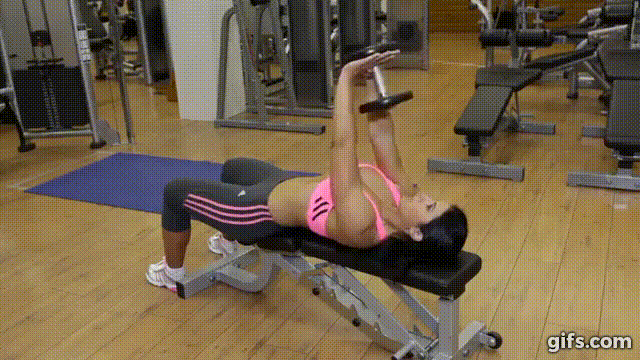During the period of popularization of bodybuilding in the 1950s and ’60s, the pullover retained its status of an essential exercise for upper body sculpting. Having in mind that they considered having thick barrel chest an ideal, the pullover fitted perfectly in their plan.
By the 1970s and ’80s, the gyms were better equipped and had greater variety of specialized machines for targeting specific bodyparts. Even the pullovers got their own mechanized variation in the Nautilus pullover machine invented in the early ’70s by Arthur Jones.
However, the greater reliance on machines was also the reason for the drop in popularity of some old-school free weight classics, such as the free-weight pullover. As a result, its popularity diminished in the ’90s. Since then, its reputation has been tarnished by various “exercise scientists” who managed to kill its good name by saying that it was ineffective, and dangerous for the shoulders.
On the other hand, this is the complete opposite to the testimonials from legends, who have nothing but praises when it comes to the pullover, and for all the different reasons.
Arnold credits his epic chest to performing dumbbell pullovers. On the other hand Dorian Yates and Mike Mentzer worked their lats on the the classic Nautilus pullover machine. The heavy pullovers have been part of Ronnie Coleman’s back training, while Frank Zane attributed his serratus muscles development to doing pullovers from young age.
You must admit that this is an impressive list of names of people with enough gravity to make any armchair fitness expert blush. It’s up to you to choose whose lead to follow.
The main argument against pullovers is the fear of shoulder injuries. After all, this exercise puts your body in an awkward pose of your body while moving a heavy weight with fully extended arms over your face. So if you don’t have enough strength in your shoulders and good shoulder mobility it can be straining.
However, by working on your shoulder and upper back mobility you can overcome this problem. To test if you are ready for the pullover, try whether you can perform overhead press or chin ups with full range of motion.
Once you are certain that you have sufficient shoulder mobility you can try your hand at this classic move.
During the period of popularization of bodybuilding in the 1950s and ’60s, the pullover retained its status of an essential exercise for upper body sculpting. Having in mind that they considered having thick barrel chest an ideal, the pullover fitted perfectly in their plan.
By the 1970s and ’80s, the gyms were better equipped and had greater variety of specialized machines for targeting specific bodyparts. Even the pullovers got their own mechanized variation in the
Nautilus pullover machine invented in the early ’70s by Arthur Jones.
However, the greater reliance on machines was also the reason for the drop in popularity of some old-school free weight classics, such as the free-weight pullover. As a result, its popularity diminished in the ’90s. Since then, its reputation has been tarnished by various “exercise scientists” who managed to kill its good name by saying that it was ineffective, and dangerous for the shoulders.
On the other hand, this is the complete opposite to the testimonials from legends, who have nothing but praises when it comes to the pullover, and for all the different reasons.
Arnold credits his epic chest to performing dumbbell pullovers. On the other hand Dorian Yates and Mike Mentzer worked their lats on the the classic Nautilus pullover machine. The heavy pullovers have been part of Ronnie Coleman’s back training, while Frank Zane attributed his serratus muscles development to doing pullovers from young age.
You must admit that this is an impressive list of names of people with enough gravity to make any armchair fitness expert blush. It’s up to you to choose whose lead to follow.
The main argument against pullovers is the fear of shoulder injuries. After all, this exercise puts your body in an awkward pose of your body while moving a heavy weight with fully extended arms over your face. So if you don’t have enough strength in your shoulders and good shoulder mobility it can be straining.
However, by working on your shoulder and upper back mobility you can overcome this problem. To test if you are ready for the pullover, try whether you can perform overhead press or chin ups with full range of motion.
Once you are certain that you have sufficient shoulder mobility you can try your hand at this classic move.

 Share On Facebook
Share On Facebook 
 Share On Facebook
Share On Facebook  Share On Facebook
Share On Facebook